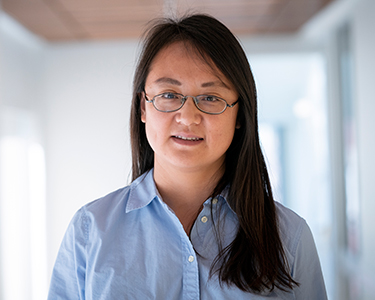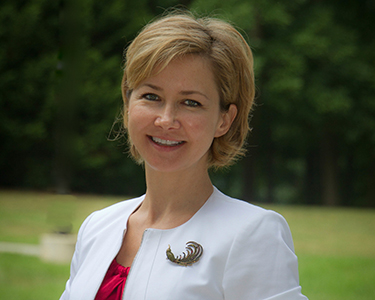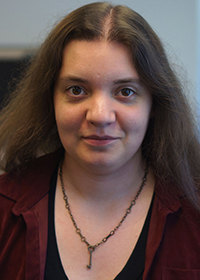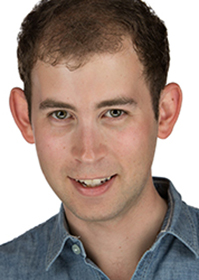
Qi Wei, an associate professor in the Department of Bioengineering, received a Teaching Excellence Award with special recognition in High Impact Learning from the Stearns Center for Teaching and Learning,
Teaching is a two-way street, and award-winning professors say they learn valuable lessons from their students.
Four Mason Engineering faculty members recently won prestigious educational awards. Qi Wei, an associate professor of bioengineering, received a Teaching Excellence Award with special recognition in High Impact Learning from the Stearns Center for Teaching and Learning, and Ioulia Rytikova, an associate professor of information sciences and technology; Katherine “Raven” Russell, MS computer science ’12, an instructor in the Department of Computer Science; and Jon Bell, an assistant professor of computer science, received Teacher of Distinction Awards from the center. Here’s a look at some of their insights about teaching:
Bioengineering professor admires students' ingenuity
Wei, who teaches biomedical data analytics, introduction to biomechanics, and advanced biomechanics, says students’ comments at the end of the semester have taught her that they value professors who encourage, respect, and listen to them.
“Students are more open to asking questions and engaging in the class if they feel the teacher cares about them and acknowledges their effort,” she says. “From the feedback I have gotten, I realize that we educators can make an impact on their career and beyond.”
It’s rewarding to see students go from knowing very little about the subject matter at the beginning of the semester to understanding it in much greater depth by the end, she says.
She especially enjoys the project presentations during the last few classes. “They are excited about their projects and humbly share them with the rest of the class. The audience is engaged and asks many interesting questions.”
Wei says she loves watching students’ ingenuity in solving problems. “I am constantly amazed by the different ways they think about concepts and come up with unique computer programs. Some are quite different from how I would solve them.”

Ioulia Rytikova, an associate professor in the Department of Information Sciences and Technology, received a Teacher of Distinction Award from the Stearns Center for Teaching and Learning.
IST professor researches ways to improve teaching
Rytikova, who teaches classes in the big data and data analytics field, says the most important lesson she has learned over the past 15 years of her career is the value of active learning.
To engage her students in active learning, she presents them with real-world problems, then they work in teams to come up with possible answers. She uses their answers in her short, precise lectures.
“It turns a difficult, potentially dull subject into something enjoyable for everyone,” says Rytikova, who is co-director of Mason Engineering’s Personalized Learning in Applied Information Technology Laboratory, where she has researched and developed innovative teaching techniques.
The active-learning classroom affects students in many ways. Some say her class made them rethink the way they approached learning. Others have told her it influenced their career direction,
The payoff for connecting with students is huge. “I am a firm believer in the power of education to shape people,” she says. “Today, more than ever, educators are uniquely positioned to inspire students to find their voice and achieve their full potential.
“Helping a young person develop the abilities and skills essential for a lifetime of success is what I most enjoy about teaching.”

Katherine “Raven” Russell, MS computer science ’12, an instructor in the Department of Computer Science, received a Teacher of Distinction Award from the Stearns Center for Teaching and Learning.
Instructor enjoys her students’ passion for computer science
Russell, who teaches several computer science (CS) classes, including the introductory course as well as 300-level classes, thrives on getting feedback from her classes. “I enjoy the students’ enjoyment,” she says. “I get to entertain people with all the things I think are exciting and cool, and then they think they are exciting and cool.”
She knows she has done her job when students say things like, “I liked this class so much that I changed my major to computer science,” or “I’m not sure about CS, but I really enjoyed your class.”
Even in large lecture classes, Russell uses active-learning techniques by presenting a problem to the class and having the students work together to solve it. “I walk around the room to watch them try to solve the problem, and I answer their questions. It’s important that they have that time,” says Russell, who worked in industry as a web developer before she came back to Mason to get a doctorate.
The transition to virtual instruction during the coronavirus pandemic went smoothly, she says. “We had to do a lot of restructuring to make sure our courses had the same difficulty level while making sure the difficulty was not worsened by everybody being home. Students absolutely have to have this information for the next courses.”
Russell says she benefited from Slack conversations with other CS faculty who shared their insights on ways to keep students engaged. “The people I work with are an awesome group of dedicated teachers. It wasn’t like any of us had to do this on our own. We worked together on it.”

Jon Bell, an assistant professor in the Department of Computer Science, received a Teacher of Distinction Award from the Stearns Center for Teaching and Learning.
Computer science professor took notes on how to make his lectures better
When Bell was considering whether to pursue a career in industry or academia, he thought he’d enjoy the teaching part of being a professor. “I was unsure of my choice since I had never taught before,” he says.
During his first few semesters at Mason, he found that sometimes after he gave a lecture, he would go back to his office and feel dissatisfied with how it went. He kept a journal and tried to understand what went well and what recurring issues he had.
Bell, who teaches courses in distributed systems, web development, program analysis, and software testing, worked hard to improve his teaching techniques and realized that students were willing to grant him grace.
One time he way underestimated the amount of time a project would take, but when he got back the course evaluations for the class, he received 5 out of 5 on the instructor rating question from every student. “I was shocked and humbled,” he says.
Over time, he says, “it became clear to me that I have poured so much time into teaching because it is something that I love—and that this is the career for me.”
